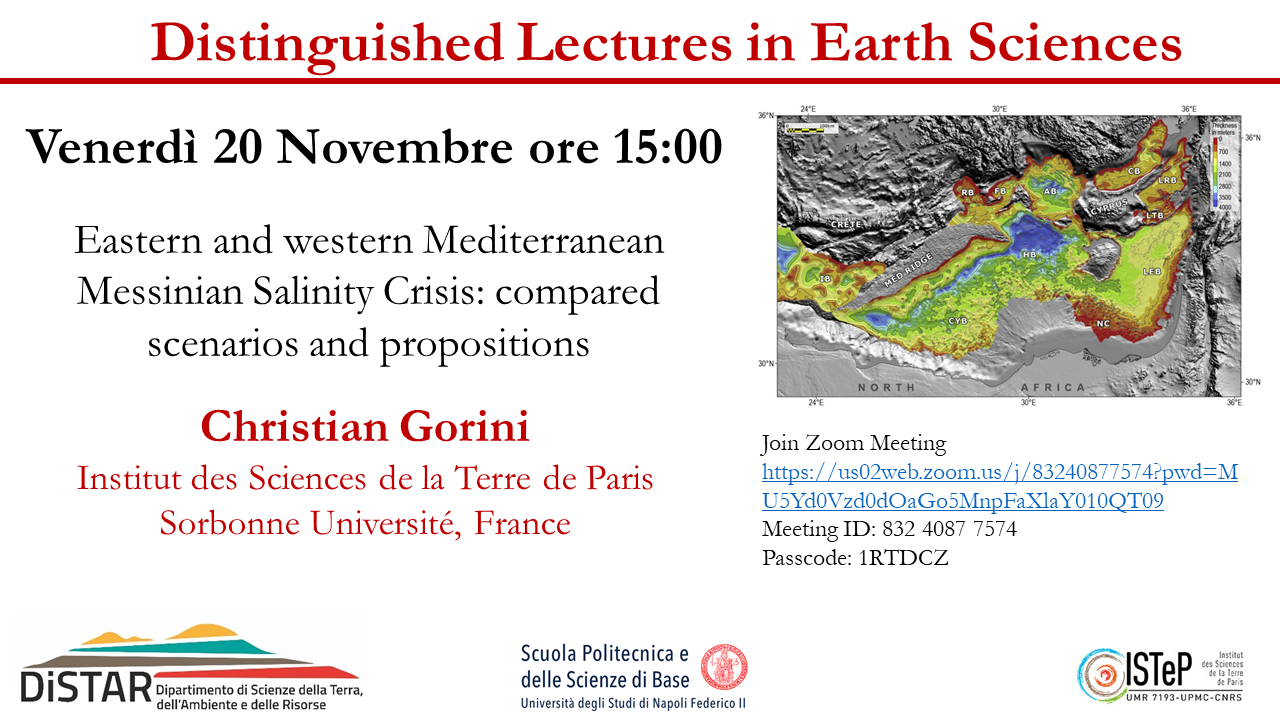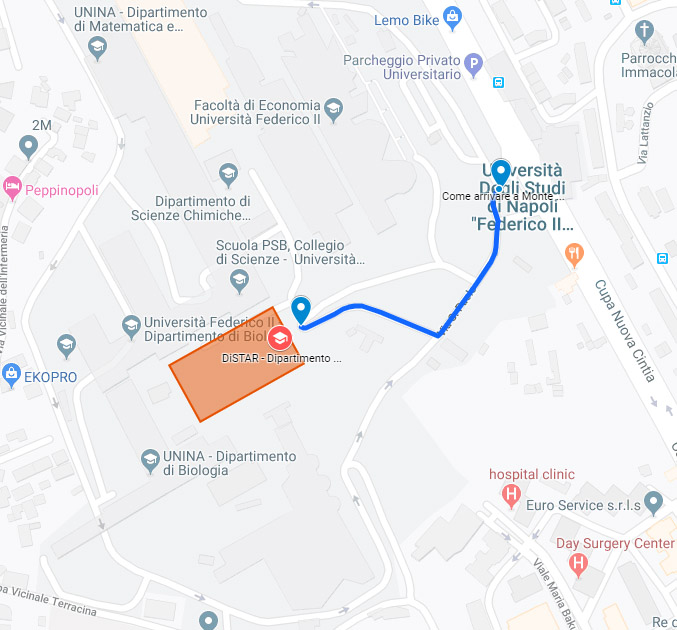Via Vicinale Cupa Cintia 21
Venerdì 20 Novembre alle ore 15 ospiteremo un webinar di Christian Gorini (Institut des Sciences de la Terre de Paris, Sorbonne Université, France), dal titolo:
Eastern and western Mediterranean Messinian Salinity Crisis: comparing scenarios and propositions
Questo è il link per partecipare al webinar sulla piattaforma Zoom
Join Zoom Meeting
https://us02web.zoom.us/j/83240877574?pwd=MU5Yd0Vzd0dOaGo5MnpFaXlaY010QT09
Meeting ID: 832 4087 7574
Passcode: 1RTDCZ
Il webinar andrà anche in streaming sul canale youtube del DiSTAR

Abstract
The partial sequestration of the Mediterranean Sea from adjacent oceans at the end of the Miocene caused an evaporation surfeit that increased the water salinity above the seafloor of the deep central basins and shallow peripheral basins. As a result, an up to 2-3 km-thick sequence of evaporites was deposited in the center of the deep basins. This coincided with intense subaerial erosion of the adjacent margins and important gravitational processes all around the Mediterranean slopes. The volume of evaporites deposited in the deep basins implies a periodic connection with the world oceans concomitant with a huge evaporation during all the Messinian Salinity Crisis (MSC). “Deep basins” refers to their position in the deep central parts of the extant Messinian basins in the Western Mediterranean Basin, the Central Basins (Ionian) and the Eastern Mediterranean Basins. In this presentation using new kinematic reconstruction of the Central Mediterranean Sea we discuss the connections between the Atlantic waters and the Eastern Mediterranean Sea, and we show that: (1) there is no contradiction between the deposition of the first deep water evaporites and a sea-level fall of more than 1000 m; (2) by a threshold effect the Eastern Mediterranean could have been more restricted than the Western Mediterranean during first phase of the MSC (3) at the end of the MSC, the threshold effect of the Sicilian-Calabrian corridor could have been maximal with an accommodation space almost filled up and a bathymetry probably not exceeding 50 m in the Western Mediterranean and in the Central Mediterranean with deposition of K and Mg evaporites, 4) at the end of the MSC an almost zero bathymetry characterized the Eastern Mediterranean as shown by fluvial networks developed on a wide-spread erosional surface during the upper Unit deposition (Nahr Menashe Fluvial system) on top of the Levant basin salt; (4) the MSC ended with the rapid flooding of the Mediterranean Sea. We propose a two-step flooding in the Western Mediterranean could find its origin in this threshold effect between Western and Eastern Mediterranean.
Key-words: Mediterranean Sea, Salinity Crisis, gravity processes, Salt thickness, Sicily-Calabria corridor, Threshold effect, Tyrrhenian sea.
Biosketch
 Christian Gorini is a full Professor of Sorbonne University specialized in marine geology and basin research. He received a B.Sc. in geology from Toulouse III University in 1990. During his doctorate at the University of Toulouse III (1991-1993) he started to study the geodynamics and stratigraphic evolution of the Western Mediterranean Basins, in the offshore and onshore Liguria Provençal margins.
Christian Gorini is a full Professor of Sorbonne University specialized in marine geology and basin research. He received a B.Sc. in geology from Toulouse III University in 1990. During his doctorate at the University of Toulouse III (1991-1993) he started to study the geodynamics and stratigraphic evolution of the Western Mediterranean Basins, in the offshore and onshore Liguria Provençal margins.
Before starting an academic career in Lille in 1997, Christian was an expert geologist in high resolution marine geophysics acquisition and interpretation of unexplored offshore areas for Beicip, Fugro and other international companies. He acquired a strong experience at sea on board of different oceanographic vessels, working in international companies all around the world.
One of his important contributions consists in the knowledge of a huge Paleo-environmental crisis: the Messinian salinity crisis recorded in the deep western and eastern Mediterranean basins. Moreover, his research is focused on the sedimentary record and cyclicity from shelf depositional systems to slope architectures around south Atlantic (Niger delta, Foz do Amazonas basin, Santos margin) and Mediterranean margin. He has a worldwide experience in seismic and sequence stratigraphy and their application in basin research, paleoceanography, geological hazards and hydrocarbon exploration.
 Italiano
Italiano  English
English 




